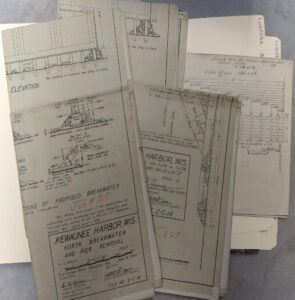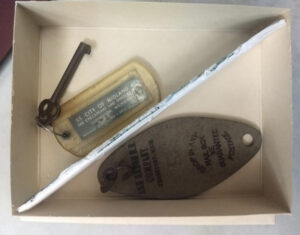Marian Matyn
Clarke Historical Library
As the Archivist and an Associate Professor at the Clarke Historical Library, I’m pleased to use this column to highlight some of the library’s Great Lakes Maritime history resources, documents, and collections from the 19th and 20th centuries. The Clarke is a historical library and archives established in 1954 at Central Michigan University (CMU), which began as a teacher normal school. We mainly collect Michigan history in the northern part of the Lower Peninsula, Mackinaw to Lansing. The collection increased over time through the efforts of staff and donors from 1954 to present.
The Clarke’s maritime collections represent CMU’s deep connection to Michigan and all the Great Lakes. CMU cultural resource and history classes and maritime historians use the collections that encompass a wide range of topics of local, regional, and global interest from the collected research papers and resources of local historians and preservationists Dr. Charles E. and Jeri Baron Feltner to original documents that demonstrate the breadth, depth (both literally and figuratively) and dangers associated with Great Lakes shipping, shore work, transport, and everyday life.
In addition to materials similar to what you might locate at most repositories for maritime history, CHL houses oral histories connected to shore life and to the protection of maritime shipping and history. The Great Lakes Lighthouse collection, in particular, provides rare insights into how lighthouse keepers understood their role and their importance to the Lakes.
I am highlighting a few of the many collections I have processed and cataloged, making them available to researchers; some are available online and the remainder are currently available at the Clarke. The collections are accessible through our catalog (https://www.cmich.edu/research/clarke-historical-library) and those with finding aids are available via online Google-searchable finding aids (https://quod.lib.umich.edu/c/clarke/).
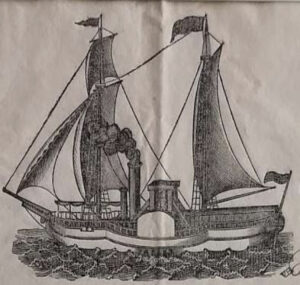
Figure 1: A finely detailed, professional drawing of Walk-in-the-Water. The first steamer on Lake Erie, Huron and Michigan, graces the top of the original June 21, 1819 manifest printed on rag paper. (Clarke Historical Library)
While the Clarke has a number of original and microfilmed manifests, this one is individually boxed and cataloged because it is the only one with a drawing, and because of what the drawing represents. Created by an unidentified artist, the dynamic drawing depicts the vessel’s departure from Mackinac to Black Rock, New York; the ship appears underway, with sails full and the steam funnel pumping smoke. Her voyage represented a turning point in Great Lakes maritime history, illustrating major technological change and possibility.
Michiganders in 1819 realized that steamers would facilitate and accelerate the shipping of people and goods for economic and regional development, as the Territory of Michigan was propelled toward statehood (in 1837). Thus, an artist was hired before the vessel left Mackinac, and someone, we presume the ship’s owners, ? printed a special manifest on a printing press, including the drawing. Time, thought, and funds were prioritized and organized to create this item. Many early original manifests no longer exist. The Walk-in-the-Water’s survived, carefully preserved for more than two centuries by Michigan maritime historians who recognized the vessel’s identity as a marker of changing maritime history.
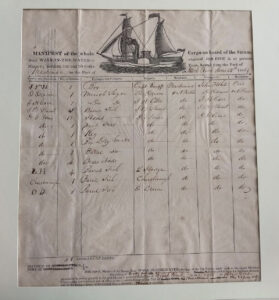
Image 2: Full manifest of the Walk-in-the-Water, June 21, 1819, printed on rag paper. (Clarke Historical Library)
As respected, dedicated researchers, as well as writers and editors on the maritime history of all five Great Lakes, the Feltners were instrumental in establishing the Straits of Mackinac Shipwreck Museum and preserving the DeTour Reef Light (lighthouse). They donated their personal papers and research notes to the Clarke and the 61 boxes of the Dr. Charles E. and Jeri Baron Feltner Great Lakes Maritime History Collection, 1978-2018, holds wide appeal for maritime enthusiasts. Among the first to document many Great Lakes shipwrecks, the Feltner’s documentation is unique, detailing not just their findings, but the early days of maritime research and recovery with new tools and technologies. Research topics you can dip into include: the detailed history of hundreds of vessels which sailed on or sank in all of the Great Lakes through the late 20th century, Great Lakes deep diving, maritime history (American and Canadian), shipping history, major Great Lakes storms of 1905 and 1913, rare insurance materials, marine casualties, merchant vessels, certificates of enrollment, sailing, shipbuilding/construction, and underwater logging.
From a surface skim to a deep dive, the Feltners’ Digital Great Lakes Maritime History collection, though a single box, includes a 2018 DVD of their 1999 deep dives to the shipwrecks of the steamer Eber Ward and the brig Sandusky. The dive recorded the ship’s near pristine condition and shows the cover of invasive mussels. Play the DVD and you can explore, virtually, the stunning wrecks, sunk deeply in the Straits of Mackinaw. Great Lakes marine historians and divers watch the films to understand how the wrecks looked before the mussels obscured their details and the mussel invasion shows the rapid change to Great Lakes ecology.
Luedtke Engineering Company Organizational Records (Frankfort, Mich.), 1932-2009, in 375 boxes, documents the history of the leading marine construction firm in all the Great Lakes and Midwest. You can plunge the depths of the Job series to explore every completed job with records detailing bids, contracts, communications, architectural drawings, and site photographs. The completeness of the records allows a researcher to understand the growth of port cities over decades based on how and when their marinas, piers, or breakwaters were built, continuously expanded, and modernized to accommodate growing marine traffic, the shift of the maritime economy into tourism, as well as efforts to protect shorelines from erosion.
If coastal history is your area of expertise, you can find amazing resources in the Great Lakes Lighthouse Keepers Association (GLLKA) 21 boxes of Organizational Records, 1984-2007, regarding all Great Lakes Lighthouses, their preservation work on St. Helena, oral histories GLLKA volunteers conducted with GLLKs and their families in multiple locations, numerous publications and resource guides. These oral histories are some of the numerous, wide ranging recordings in Clarke.
Related collections you might enjoy reading—or sinking into for research include those of GLLKA founder Dick Moehl and GLLKA member Sandra L. Planisek, who planned, created, and initially operated the Icebreaker Mackinaw Maritime Museum on the decommissioned U.S. Coast Guard Cutter Mackinaw (WLGB-83), moored in Mackinaw City.
Or, focus on the 25 boxes of Captain William C. Bacon’s Michigan Car Ferries Collection, 1883-2010. Ferries were the fastest means of transporting people and goods between Michigan and Wisconsin, as well as between the two peninsulas of Michigan for over 100 years until the Mackinac Bridge was erected in 1957.
For over 32 years Captain Bacon served the Ann Arbor Railroad Company that operated a ferry line. He collected extensively on the history of Michigan car ferries, car ferry companies, and car ferry port cities, using his insider knowledge of the companies to build his collection. A history of the line, and each ferry put into service can be seen in the photographs, blueprints, correspondence, certificates of inspection and enrollment, logbooks, sales, reconstruction, and casualty records, and keys within the collection.
Finally, you might immerse yourself in the construction of the Soo Locks, a major passageway for Great Lakes vessels, constructed by the U.S. Corps of Engineers. The archives staff created a database for the collection after digitizing 1,731 glass plate negatives from the years 1885-1941. The database enables researchers to browse or use keyword searches to find the people and vessels that helped build the locks, the ships that passed through, or ships involved in accidents, (https://www.cmich.edu/research/clarke-historical-library/explore-collection/explore-online/michigan-material/sault-ste-marie-constructing-locks). For example, a keyword search for the Susan E. Peck retrieves the image below, originally titled “Wreck of Steamer Susan E. Peck w Schooner Geo. W. Adams, Oct. 12, 1891.”
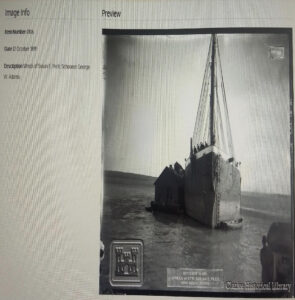
Image 4: Wreck of Steamer Susan E. Peck w Schooner Geo. W. Adams, Oct. 12, 1891 retrieved from the Soo Locks collection database. (Clarke Historical Library)
The Clarke continues to collect Great Lakes maritime history collections and we welcome donations. If you are interested in any of this material or would like to find out more about CMU’s maritime holdings, contact Marian at marian.matyn@cmich.edu.
(Return to December 2022 Table of Contents)

